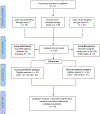Infant Colic Represents Gut Inflammation and Dysbiosis
- PMID: 30177353
- PMCID: PMC6669027
- DOI: 10.1016/j.jpeds.2018.07.042
Infant Colic Represents Gut Inflammation and Dysbiosis
Abstract
Objective: To dissect potential confounding effects of breast milk and formula feeding on crying + fussing, fecal calprotectin, and gut microbiota in babies with colic. We hypothesized that infant colic is associated with gut inflammation linked to intestinal dysbiosis.
Study design: A nested case-control design of 3 of our studies was used to analyze clinical and laboratory data at presentation, comparing babies with colic with controls. All investigators other than the biostatistician were blinded during data analysis. Subjects were recruited based on their age and crying + fussy time. We screened 65 infants, 37 with colic, as defined by Barr diary (crying + fussing time >3 hours daily), who were compared with 28 noncolicky infants.
Results: Fecal calprotectin was elevated in babies with colic. For each mode of infant feeding (breast milk, formula, or breast + formula), infants' fecal calprotectin was higher in babies with colic. Infants with colic had similar levels of fecal alpha diversity (richness) when compared with controls, and alpha diversity was lower in breast-fed babies. Beta diversity at the phylum level revealed significant differences in microbial population. A phylum difference resulted from reduced Actinobacteria (95% of which are Bifidobacilli) in babies with colic. Species significantly associated with colic were Acinetobacter and Lactobacillus iners.
Conclusions: Colic is linked with gut inflammation (as determined by fecal calprotectin) and dysbiosis, independent of mode of feeding, with fewer Bifidobacilli.
Trial registration: Clinicaltrials.gov: NCT01279265 and NCT01849991.
Keywords: calprotectin; crying; functional bowel disorder; intestinal inflammation; microbiota; newborn.
Published by Elsevier Inc.
Figures







Comment in
-
Dreimonatskoliken: Dysbiose im Darm.MMW Fortschr Med. 2018 Dec;160(21-22):41. doi: 10.1007/s15006-018-1231-4. MMW Fortschr Med. 2018. PMID: 30542864 German. No abstract available.
References
-
- Wessel MA, Cobb JC, Jackson EB, Harris GS Jr, Detwiler AC. Paroxysmal fussing in infancy, sometimes called colic. Pediatrics 1954; 14:421–35. - PubMed
-
- Harb T, Frederiksen N, Hill RJ. Is sensory processing an issue for infants with colic? Infant Behav Dev 2017;48:105–13. - PubMed
-
- Vandenplas Y, Alarcon P, Alliet P, De GE, De RN, Hoffman I, et al. Algorithms for managing infant constipation, colic, regurgitation and cow’s milk allergy in formula-fed infants. Acta Paediatr 2015;104:449–57. - PubMed
-
- de Weerth C, Fuentes S, Puylaert P, de Vos WM. Intestinal microbiota of infants with colic: development and specific signatures. Pediatrics 2013;131:e550–8. - PubMed
Publication types
MeSH terms
Substances
Associated data
Grants and funding
LinkOut - more resources
Full Text Sources
Other Literature Sources
Medical

